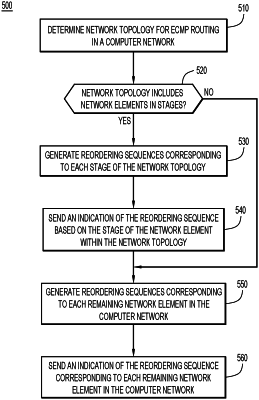| CPC H03M 13/09 (2013.01) [H04L 1/0041 (2013.01); H04L 1/0061 (2013.01); H04L 45/7453 (2013.01); H04L 47/125 (2013.01)] | 20 Claims |

|
1. A method comprising:
obtaining a network topology for a network to provide load balancing for packets in network flows, the packets associated with a Load Balancing Flow Vector (LBFV) corresponding to flow attributes of the network flows;
determining whether the network topology includes a first stage comprising a plurality of first network elements and a second stage comprising a plurality of second network elements, wherein the packets in the network flows pass through only one of the plurality of first network elements and only one of the plurality of second network elements;
responsive to a determination that the network topology includes a first stage and a second stage, generating a first reordering sequence and a second reordering sequence different than the first reordering sequence;
providing the first reordering sequence to the plurality of first network elements in the first stage, the first reordering sequence enabling the plurality of first network elements to load balance the packets in the network flows by reordering a corresponding LBFV before selecting a first next hop; and
providing the second reordering sequence to the plurality of second network elements in the second stage, the second reordering sequence enabling the plurality of second network elements to load balance the packets in the network flows by reordering the corresponding LBFV before selecting a second next hop.
|